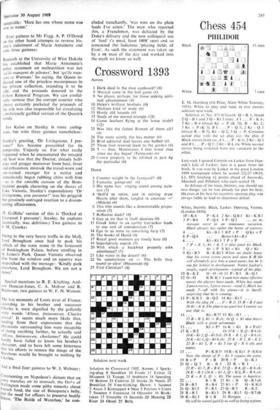Chess 454
PHILIDOR
E. M. Hassberg (1st Prize, Alain White Tourney, 1951). White to play and mate in two moves; solution next week.
Solution to No. 453 (Chicco): Q - R 1, threat 2Q-B1 and 3Q-Kt 5 mate.A 1 ...P-K 6; 2 Kt - B 4 (threat Kt x P (K 7)), R - Kt 2;
3 Kt x P (K 5). B 1 . . . P - Q 5; 2 Kt - Q 3 (threat R - B 5), Kt - Q 2, 3 Q x P. Compare actual play with the set play (i.e. the play if Black moves first) viz. A 1 P - K 6; 2 Kt - Q 3 and B 1 P - Q 5; 2 Kt - B 4, the White second
moves being switched from one variation to the other.
Last week I quoted Einstein on Lasker from Han- nak's Life of Lasker; here is a game from the book. It was won by Lasker in the great London 1899 tournament where he scored 221/27 (W19, LI, D7) finishing 4/ points ahead of Janowski, Marshall and Pillsbury who each scored 18.
In defence of the loser, Steinitz, one should say two things: (a) he was already far past his best; (3) even at his best his eccentric opening play was always liable to lead to disastrous defeat.
White, Steinitz. Black, Lasker. Opening, Vienna. (London 1899).
1P-K4 P-K4 2 Kt-QB3 Kt-KB3
3 P-B4 P-Q4 4 P-Q3 an In- nocuous move in an innocuous variation. Black already has rather the better of matters. Kt-B3 5 BP x P QKt x P 6 P - Q 4 ... Better 6 Kt - B 3 Kt-Kt 3 7 P x P 7 P - K 5, Kt - K 5 is also good for Black. Kt x P 8 Kt x Kt Q x Kt 9 Kt-B 3 B-K Kt 5 White no doubt hopes that his extra centre pawn and open K B file will ultimately give him a good game, but he is too far behind in development. Notice Lasker's simple, rapid development—typical of his play.
10 B-K2 0-0-0 II P-B3 B-Q3
12 0-0 K R-K 1 Count how many effective moves the players have made. White has made 2 pawn moves, 3 piece moves—total 5; Black has made 7—all with his pieces—it is hardly surprising that he is winning.
13 P-KR3 B-Q2 14 Kt-Kt5
With the idea 14 . . . P - B 3; 15 B - B 3 and 16 K 4. The plan is no good but 1 cannot see one that is.
14 ... Kt-R5! 15 Kt-83 .
15 B - B 3, Kt x B c h; 16 Q x Kt also leaves Black with a great advantage.
15... Kt x P! 16 K x Kt B x Pch!
17 K-B2 Or 17 K x B,Q-B 4 ch;
18 K-Kt 2,Q-Kt 5ch; 19 K - R 1,Q- R 6 ch; 20K-Kt 1,Q-Kt 6 ch; 21 K - R 1, R-K 5; 22 B - Kt 5, R - Kt 5 (or Q - R 6 ch) and mates.
17 P-KB3! 18R-KKt1 P-KKt4 Now the threat of P - Kt 5 regains the piece.
19 BxP PxB 20RxP Q-K3 21 Q-Q 3 B-B 5 22R-RI
22 R - Kt 7, B - B 4; 23 Q - B 4, Q - K 6 ch; 24 K - B 1 (24 K - 1, Q - Kt), B - R 6 ch; 25 K - K 1, Q x Kt. The game is hopeless.
22... B x R 23 Kt x B Q-B3ch 24 B-B3 B-B4 25 Kt x P Q-KKt3 26 Q-Kt5 P-B3 27Q-R5 R-K 2 28 R-R5 B-Kt5 29 R-Kt5 Q-B7dt 30 K -Kt 3 B x B 31 Resigns . • .
He will be mated quickly as wel 1 as losing apiece.


































 Previous page
Previous page